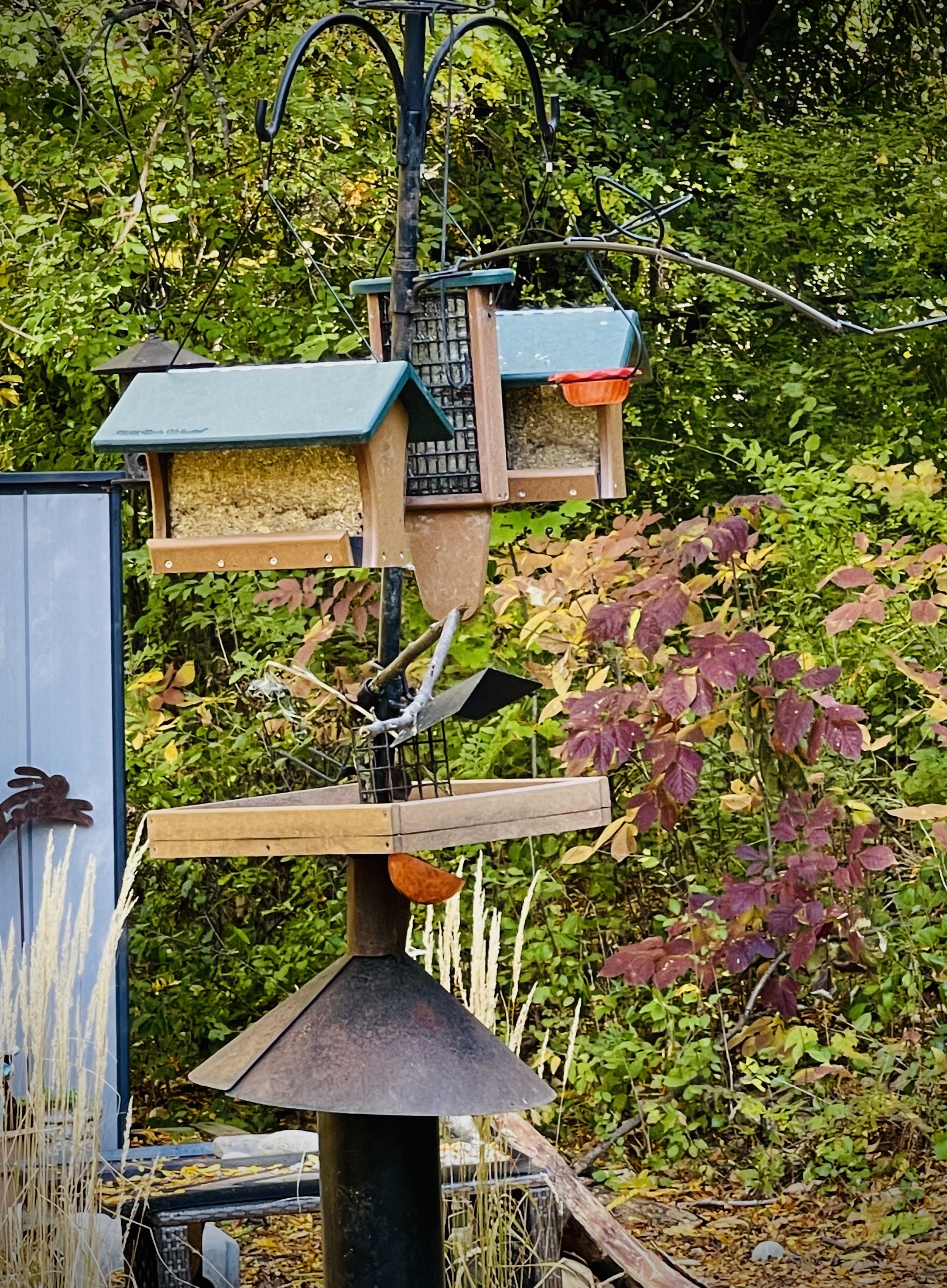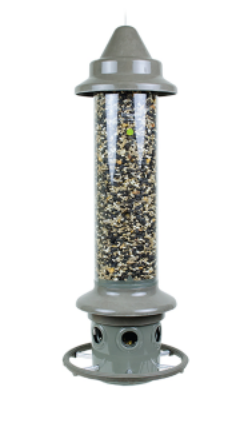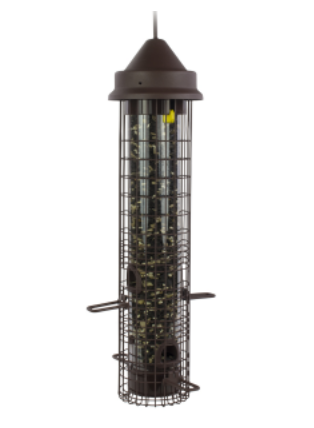Squirrel proof bird feeder strategies: Going for gold
Best squirrel proof bird feeders: How to set up a feeding station and cages to keep them out
Our squirrels train everyday to beat us at our own game. Like the ultimate Olympian, they don’t seem to give up, don’t feel fear, and don’t seem to care about a little pain or even feel sorry for us when they win gold and walk away with a full belly of our finest bird food.
A cage helps, so do weight-sensitive feeders, but it takes more than just throwing them up in the nearest tree to guarantee successs.
So how do we keep squirrels out of our bird feeders?
They know what so many of us fail to accept – there are no squirrel proof bird feeders. There are feeders that work well most of the time and baffles that stop them in their tracks – for a time anyway – but there is nothing that can guarantee that squirrels aren’t getting fed on any given day.
We can try to keep squirrels at bay with a host of elaborate combinations baffles, cages and pressure sensitive feeders, but in the end there is always that one squirrel that accepts any challenge we throw at it with great gusto.
I have a name for these squirrels. I call them my Olympic calibre squirrels and right now we have one that comes in the form of a large grey male squirrel that, I swear, has no respect for me, my expensive bird feeders or the baffles meant to keep him on the ground.
My approach to keeping the squirrels off my feeders is a simple one and involves a single, centralized feeding station in an area where the squirrels are unable to access from above or from ground level.
He may not respect me, but I have the utmost respect for him.
I can live with one squirrel occasionally getting up on the feeder. The problem is when the entire neighbourhood has access to my expensive feed.
And, I can say with great certainty that there are very few yards with more squirrels than mine. Winter, spring, summer, fall, it doesn’t matter. There are always a handful of squirrels looking for a handout. Grey, black and red squirrels with a good mix of chipmunks thrown in just for fun.
Our resident red fox has taken care of some of them but the squirrels and chipmunks are always ready to restock with their kin whenever the numbers get manageable.
So it goes without saying that my vigilance is paramount at all times.
Harming squirrels is not the answer
First, let me say that I never harm our squirrels in any way. I don’t use the hot, spicy bird seed and I refuse to use the spinning feeders that just seem cruel to me. Maybe the squirrels like to go for a spinny ride once in a while, but I can’t help but think that the spinning feeders go just a little too far to protect a handful of bird seed.
My approach to keeping the squirrels off my feeders is a simple one and involves a single, centralized feeding station in an area where the squirrels are unable to access from above or from ground level. Although there are a lot of trees around the feeder, any limbs are kept cut back enough that even an Olympic calibre squirrel can’t score a medal with its best jump.
By using a bird feeding station rather than individual feeders, I am able to use a number of different, less expensive feeders and specialty feeders that the squirrels can’t get to. These include everything from simple hopper feeders to suet feeders and compressed seed cylinders.
The key is to keep the feeding station away from areas that allow the squirrels to jump up or down on the feeders.
I could give readers specific distances that the feeder station needs to be away from objects where the squirrels are capable of leaping from, but I think every situation is unique and needs a certain amount of individual experimentation. A good starting point, however is at least four feet off the ground and about ten feet from above for the daring aerial acrobats.
Our biggest weakness is usually an approach from ground level where, like a basketball player, a good vertical jumper can score almost every time.
The most success our squirrels have had is when I have left a feeder dangle too low to the ground.
Our most talented athletes manage to take a running leap off the large baffle flinging themselves into the air – often with an impressive twist or even what appears to be a salkow? – and then grasping the feeder with a toe hold any Olympic wrestler would be proud to have in their arsenal.
Squirrel and raccoon baffles are excellent deterrents
I use a combination of a large steel raccoon baffle as a first defence followed by a cap baffle (see image above) that sits on top of the raccoon baffle and provides the final defence. If they can jump past this combination, the bird seed is toast.
Once defeat is guaranteed, I’ve got one more deterrent that works well. Like any good defence, it involves bending but not breaking and works on the premise that all that work to get up on the feeders probably isn’t worth it.
I like to call it “the pantry is almost empty but go ahead and help yourself.”
It involves simply refraining from the urge to fill up your feeders to the point where it’s not really worthwhile for the squirrels to make the effort to get on the feeders. This won’t stop them for a second, but it will cut your losses if one or two manage to out jump your barriers and go for gold.
What if you can’t or don’t want to use a single pole bird feeding station?
There are lots of reasons to not want to use a centralized feeding station in your yard.
I love the look of beautiful bird feeders hanging in a tree being visited by cardinals, chickadees and a host of finches.
It’s an idyllic look in any woodland garden and one that we should all be able to enjoy without the annoyance of having squirrels swinging like monkeys from every bird feeder in the yard.
There are lots of options available. A quick search on Amazon provides a long list of squirrel proof feeders with some obviously more effective than others.
Squirrel deterrent feeders can be expensive
The answer involves the ability to dig into your pocket, pull out your wallet and hit the cashier at the high-end bird feeding store with your credit card without flinching.
It can get expensive.
A good feeder is not cheap, but there are reasons feeders designed to keep squirrels at bay without a series of baffles and bobbles can get very expensive.
First there is the feeder itself. If you are buying, pay what it takes to get a good one preferably one that shuts out squirrels and other critters depending on their weight.
Wild Birds Unlimited, for example, sells its “Eliminator” model that closes off access to the seed once the squirrel sits on the base of the feeder.
Wild Birds Unlimited describes how the feeder works: “When a squirrel touches the perches or perch ring, its weight closes the seed ports, foiling its seed-stealing plot. The Eliminator’s unique technology allows you to set the sensitivity level, so you can also exclude large birds such as pigeons or doves.”
Does it work? Absolutely. Can squirrels figure out a way around it? Absolutely. They will try their best to hang from a branch or even the top of the feeder so they do not add weight to the spring loaded seed dispenser.
By positioning the feeder in a location that makes it difficult for the squirrels to access it from a low hanging branch, the chances of keeping the squirrels at bay increases. Consider adding a half dome to make access from the top more difficult.
But even if the squirrels can’t extract seed, the raccoons will take their turn at it once the sun goes down. The result can be an expensive birdfeeder on the ground and susceptible to a hungry, snarling raccoon. I don’t like the feeder’s chances here.
Caged bird feeders are a good choice: Droll Yankee is top choice
Add a solid cage around the feeder and the problem of squirrels and even raccoons is more or less solved.
The best caged feeders work very well. There is a reason Droll Yankee feeders are a little expensive in comparison to other feeders. Their reputation as a company that builds solid feeders that work well is undeniable.
The Droll Yankees Domed Cage Sunflower Seed Bird Feeder is an example of a bird feeder, cage and dome built to keep the critters away while providing excellent access for he birds to high quality seed.
The six feeding ports on the feeder that takes 2.5 pounds of food provides plenty of choice for smaller birds to feed.
The cage allows our smaller songbirds to eat while keeping larger birds like blue jays and starlings away from the feeders. At the same time, squirrels and other undesirables can’t get to the feeders.
The plastic dome provides some shelter for the birds during inclement weather, but more importantly helps to keep the seed dry during rain or snow storms.
Of course the Droll Yankee feeders are not the only recommended caged feeders.
The “Fundamentals Squirrel Proof Feeder” from Wild Birds Unlimited is anotheer effective caged feeder. They describe their Fundamentals feeder in the following way: “Our Fundamentals Squirrel Proof feeder is weight-sensitive, so when a squirrel gets on the feeder the feeding ports close, denying access to the seed. Birds can use the four perches or they can cling to the metal shroud to feed.
If it makes sense to add a dome over the entire feeder assembly, it can go a long way in keeping the bird seed dry, while at the same time helping to keep squirrels, chippmunks and raccoons off the feeder.
If raccoons are a problem, just try to remember to take the feeder in for the night or locked away in a safe spot outside away from the racoons but also in an area where mice and rats are not attracted to it. A large galvanized garbage can with a solid lid works for me.





